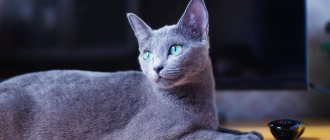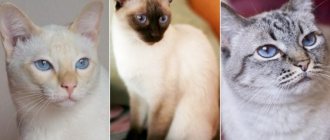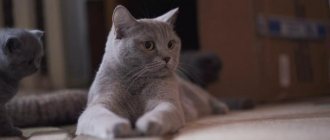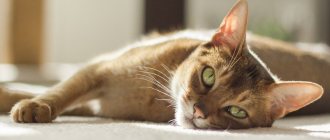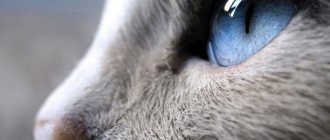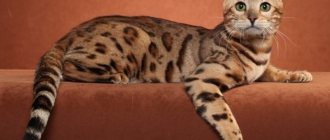- Pets
- >>
- Cat breeds
* Here is a photo of a typical representative of the Russian Blue cat breed . You can send us photos of your animals by email, and we will post them on the website. Don't forget to send your pet's name.
Other breed names:
Blue Russian
Video
* We invite you to watch a video about the Russian Blue cat . In fact, in front of you is a playlist in which you can select and watch any of 20 videos about a given cat breed by simply clicking on the button in the upper right corner of the window. In addition, the material contains quite a lot of photos. By looking at them you can find out what a Russian Blue cat looks like.
In this article:
|
Rate the material!
[Total votes: 3 Average: 5]
Mysterious Slavic charm - this is what the cats of the Russian Blue breed are called. These animals are particularly graceful and mysterious. They are very affectionate, gentle and calm. The Russian Blue cat always remains close to its owner and gets along well with children. You can have such a pet without fear and keep it in an apartment.
Nurseries
Many breeders and nurseries are engaged in mating, breeding and sale of the Russian Blue cat breed, popular in Russia. Here you can purchase pet, breed and show class animals according to standards registered in one or more felinological systems.
Professionally engaged in breeding, as an example:
- St. Petersburg, nursery “BEST BEAST”. Since 2011, he has been breeding only the Russian Blue breed, contact number 89111322080.
- Moscow, nursery “Star of the Zodiac”. Registered under the WCF system, breeds Russian Blue cats of the European type, contact phone number 8-906-734-66-36
- Moscow, nursery “Perfect Cat”. Single breed, has been breeding only the Russian Blue breed since 1998, contact phone number: +7.
- Nizhny Novgorod, nursery "Nizhny Novgorod Silver". Offers Russian Blue kittens from award-winning European-type producers, contact phone (831)2939145.
- Kaliningrad, nursery “LV* Fantasy RUSsia” Single breed, breeds only the Russian Blue breed according to the FIFE standard, contact phone +7911454258; website www.catrusfantasy.com
Important! Taking into account that there are only 2 - 4 kittens in one litter of a Russian Blue cat, therefore prestigious nurseries register potential buyers long before the pet is born.
History of the origin of Russian blue cats
“The Russian Blue cat is a native Russian animal” - this is exactly what many articles about this amazing breed say. However, this statement is not entirely true. Yes, the first progenitors were discovered in Arkhangelsk (from where they were brought to their breeding site).
But the true homeland of these amazing pets is still England. It was here that phenology exhibitions were first held in the mid-19th century. And it was here that the foundation for breeding the Russian Blue cat was laid. The creation of this breed was started by Constance Carew Cox, an English lady who was interested in phenology and was actively involved in breeding cats.
The first mention of the Russian Blue dates back to 1888 - when the breeder became acquainted with this breed. The first representative of the pedigree bore the name “Dvina”. This cat instantly won universal love and numerous prizes at exhibitions.
Later (from 1890 to 1893) representatives of the breed were imported to England from Norway and Arkhangelsk. Thanks to the careful records of Carew Cox, we reliably know the names of the cats that became the head of their clan and are considered the founders of the pedigree. These are: Kola, Olga, Limpopo, Odessa, Moscow, Yulia. It is noteworthy that photographs of some representatives of the breed from those years have survived to this day.
Interesting fact: Over the course of several decades, the breed has been actively developing and improving. But only 1935 is considered the beginning of the history of the Russian Blue. At this time, the breed was officially included in the stud book of Great Britain, classified as a “foreign type”.
At the same time, after 10 years, the threat of complete extermination of the Russian blue cat species has increased. The reason for this is the Second World War. The restoration of the breed was carried out through the efforts of breeders from all over the world. And in the 90s, Russia took a new look at these animals. Russian blue cats are no longer a rarity at professional exhibitions; they gracefully fill up all exhibition catalogs and adorn the covers of thematic magazines.
Cat health
The Russian Blue cat, the description of which indicates that it was not artificially bred, is endowed with strong immunity and does not suffer from genetic diseases. Although it is possible that cats may have squints and broken tails. But this occurs quite rarely.
To prevent your pet from getting sick, the usual preventive measures are enough:
- balanced feeding;
- proper care;
- routine checks at the veterinarian;
- vaccination.
In such favorable conditions, the breed can live up to 15 years.
Russian Blue cat - description of the breed
“Moon Queen”, “Mysterious Northern Woman”, “Russian Englishwoman” - all this is about representatives of one breed: the Russian Blue cat. Such names arose due to the unique characteristics of the animal, thanks to which it is popular throughout the world. Both in Russia and abroad there is a special attitude towards the Russian Blue breed. Pets are very affectionate, flexible, calm and friendly. Thanks to these characteristics, they easily get along in any family.
Russian Blue cats have high limbs and a long body. As adults they reach medium to large sizes.
The main body characteristics of representatives of this breed also include:
- Straight, small head with high cheekbones and a strong chin;
- Large, slightly pointed ears, set wide and slightly tilted forward;
- Almond-shaped eyes, wide-set and green in color (any shade of green is acceptable: from yellow-green to deep emerald);
- Long tail, pointed at the end from a wide base;
- Slender neck, which, thanks to the special arrangement of the shoulder blades, does not seem too long;
- Gray-blue nose;
- The pads are a dark lavender or lilac-pink type.
But the main feature of the representatives of the breed is still their coat. The coat of Russian Blues is dense, short and silky. Due to the almost identical length of the undercoat and the coat, it appears very thick, even plush. It is soft and pleasant to the touch. The standard coat color is blue-gray. A silvery tint is clearly visible, due to which this breed is often called “Lunar”.
The weight of an adult is 4.5-6 kg (males) and 3.5-4.5 kg (females). Body sizes – medium, large. The average height is 25 cm. The life expectancy of Russian pigeons is 16-20 years. Representatives of the Russian Blue do an excellent job as a pet in modern families. They are quite independent and calmly wait for their owners to return home, are friendly towards children and do not require special care.
Breed Features
Representatives of the breed are very graceful animals; they are considered one of the most graceful cats among shorthairs. The four-legged animals are slender, flexible and sophisticated. However, Russian Blues received universal love not only for their outstanding external characteristics, but also for their flexible character. Pets are very affectionate and gentle with their owners.
If we talk about the features, they are as follows:
- Weight. The breed is characterized by medium size. A newborn kitten weighs 80-120 grams. Adult cats are 3-4 kg, and males are 3.5-5.5 kg. It is typical for castrated and sterilized animals to gain weight 1.5 times more than indicated in the standard.
- Cats have proportional sizes, but the dimensions depend on individual characteristics. The average length of a quadruped is 60 cm, height 23-26 cm.
- Suit. The animals have a solid blue-gray color; there are no patterns or inclusions. Some cats sometimes have stripes on their tails.
- Lifespan. Here, a lot depends on the presence of inherited diseases, the quality of care and conditions of detention. The average is 14-16 years, some live up to 20 years.
- Character traits. Russian Blues are known for their cleanliness and obedience. Animals are very attached to their home and owners. At the same time, the animals are proud and loyal. Plush cats have not lost their hunting instincts, and therefore in the countryside they do not disdain hunting mice. However, as soon as strangers (guests) come into the house, the cat becomes very shy and unsociable.
- The intellectual characteristics of pets are also amazing; they are distinguished by intelligence and tact, are able to understand the gestures of their owners, and react to the speech and tone of the owner. Vindictiveness is not characteristic of Russian Blues, so you should not expect sabotage from them.
Popular colors of Russian blue cats
The main color of cats of this breed follows from their name - blue. Moreover, any spots, transitions and lightening/darkening are a sign of the introduction of other breeds into the pedigree, which is strictly prohibited in accordance with phenological standards. The only acceptable deviation from the norm may be barely noticeable stripes on the kittens’ bodies. However, even such spots in true representatives of their kind disappear over time.
The key features of the classic color are:
- Color density (achieved due to the thickness of the wool);
- Uniformity (the shade is the same in all parts of the animal’s body);
- Shimmer (the fur of purebred blue Russian cats shimmers with light tints).
Light lightening is permissible only in the area of the nose and ears, where the animal’s skin is visible due to the reduced thickness of the coat.
Until recently, Russian cats were really represented in the world in only one color - blue (i.e. gray with iridescence). However, in the second half of the last century, due to attempts to increase the population of this breed, two more varieties were bred.
This:
- Russian Black (Russian black) - Great Britain 1960;
- Russian White (Russian white) – Australia 1970.
Both types of animals represent deviations from the norm. They are also characterized by an exclusively solid shade without the presence of spots, stripes, or transitions. Such breeds are not recognized everywhere. They are allowed only in the phenological associations of Africa, Australia and Great Britain. At the same time, the white and black subspecies belong to the same group “Russian cats”. In other countries, these two peoples are not recognized.
Character of cats
The temperament and habits of this breed are formed as it grows, but some basic character traits are laid down from birth, sometimes transmitted by genes.
What is the peculiarity of a cat, and who would be most suitable for such a pupil:
- This is the Russian intelligentsia, which has aristocratic manners: it is soft, gentle, but at the same time independent.
- She knows how to carefully hide from sight, so as not to hurt the feelings of her owner, since she does not like to be perceived as a toy, and rarely allows herself to be stroked.
- She is active and prefers active games; she can often start real races around the apartment chasing a fly.
- A representative of this breed is balanced and quite quiet in everyday life, so she will not meow loudly and bother the owner.
- She perceives dogs as an enemy and is reluctant to be in the same room with them. In relation to birds or hamsters, she reveals her hunting instincts, so keeping such animals in the house is not always safe.
- The cat is good-natured, but not particularly obedient. It can often show its stubbornness, so training requires a lot of effort and finding a special approach to your pet.
- These furry pets love freedom and large space, but are indifferent to street walks. They would rather sit at home with their beloved owner.
Owners of this breed note a very important ability - cats can relieve tension and stress, as they have a therapeutic effect on humans.
This breed gets along well with everyone, but is more common among older people due to its calm nature.
Character and habits of Russian blue cats
Even before their inclusion in phenological classifications, Russian blue cats served as assistants to sailors on ships and were famous for their special hunting skills. Such qualities have left their mark on the character of modern individuals. Representatives of this breed are distinguished by a certain secrecy, independence, and calmness.
They treat strangers with caution, looking closely at them for a long time. The same attitude is observed towards other people's animals. Moreover, if a Russian cat still recognizes a stranger, then the manifestation of their affection and tenderness will not take long to come.
The main character traits of representatives of this breed include:
- Friendliness. Cats are absolutely not aggressive and are very easy-going. They respond well to education in childhood, quickly learning the basic rules of their existence. Animals have a particularly positive attitude towards children, steadfastly withstanding all their whims;
- Responsiveness. Thanks to their gentle nature and keen sense of smell, blue cats are great for helping to cope with depression. They feel the owner’s mood and try to improve it (if necessary) with their affection;
- Calm. Russian Blue cats are extremely calm and independent. They are not particularly fond of games and are rarely active. As for meowing, representatives of this breed rarely resort to it;
- Independence. All Russian gays are characterized by such a trait as love of freedom. However, it manifests itself differently in all animals. Most pets have completely lost this feature due to numerous phenological experiments with the genus.
Russian Blue cats are best suited to being kept in confined spaces. Such a breed should be kept in a private home only if it is possible to restrict the animal’s access to the street. Taking a walk in the yard on its own may increase your pet's sense of independence and increase interest, which can lead to you simply losing the cat.
Character
There were legends about the character of the Arkhangelsk favorite among the people. This naturally occurring cat almost never made a sound. The cat in heat and the walking cat did not scream or mark territory in the house. The dangerous period could be determined rather by the animal’s excessive affection. The rest of the time, these royal animals remained calm and equanimous, sparingly demonstrating their love for their owner. But there is no phlegmaticity or arrogance in the temperament of these animals.
They are strongly attached to their owner. They always try to keep their “ward” in sight. Possessing excellent resistance to stress, they tolerate changes quite well - departures of family members, the appearance of other pets in the house.
If there are noisy children in the house, they will become their nannies and playmates. But the claws will never come out, even if the child accidentally caused pain. But with real offenders they can confidently stand up for themselves. There are known cases when, protecting offspring, the Arkhangelsk cat successfully dispersed a pack of dogs.
The middle-aged owner will enjoy sitting next to him on long evenings, listening carefully and assenting. Absolutely not vindictive. And, even if they were scolded, they will make a dissatisfied appearance and disappear from view for some time only to return with a royal bearing as if nothing had happened a few minutes later.
Since ancient times, they have been valued by Russian people as excellent hunters. Arkhangelsk had no equal in exterminating rats and mice in the yard and house. Today, the Russian Blue demonstrates its habits in any conditions - it will never lose interest in a butterfly, fly or bird, and will keep its eye on the object for hours until it captures the prey with one precise throw.
This cat is very smart, easy to educate and even train. The necessary skills should be instilled from early childhood. Then in a city apartment there will be no problems with the pet’s scratching post and toilet.
Interesting facts about Russian blue cats
Representatives of the Russian Blue breed are interesting in all aspects: from the history of their origin to the peculiarities of their behavior at home. Animals are very graceful, beautiful and unusual. Each pet has its own unique character traits that are unique to it.
No less interesting facts about representatives of this breed include:
- Variety. Today, several types of this breed are known: Scandinavian, English and American. For representatives of each group, their own standards are put forward, characteristic of the phenological classification of a particular society;
- Royal roots. According to one version, Russian blue cats came to England not from Arkhangelsk (with the help of sailors who took these animals with them as rat catchers), but from the hands of Catherine II herself, who gave the pet as a hospitable gift to foreign guests;
- Rock climbing. All Russian cats are united by such a character trait as curiosity. Due to excessive curiosity, these animals constantly climb onto cabinets, refrigerators, and curtain rods. In this regard, pets of this breed are often called “climbers.” To prevent such curiosity from leading to property damage, it is necessary to take care in advance of the presence of multi-level cat houses in the apartment;
- Hunting instinct. When purchasing a blue Russian cat, be prepared to receive a trophy from her in the form of a mouse, lizard or even a dove. The animals have a well-developed hunting instinct. If there are other smaller pets in the house (parrots, hamsters, foot-and-mouth dogs), you need to be especially careful and vigilant;
- Tendency to obesity. Despite their gracefulness and natural thinness, representatives of the Russian Blue breed are prone to obesity. That is why their nutrition must be done in accordance with strict rules and regulations.
More interesting facts can be learned only by becoming the owner of this unusual animal. Russian blue cats constantly give positive emotions and never cease to amaze people even after several years of living together.
History of the breed
The origin of the Russian Blue cat breed is initially unknown. Supposedly, the Russian Tsarina Catherine II presented the beautiful blue, green-eyed kittens to the royal house of England, where Queen Victoria took them under her care.
For more specific information, British breeder Karen Cox decided to refresh the breed. In 1893, she acquired two cute kittens in Arkhangelsk. Initially they were nicknamed Arkhangelsk blue cats or English Archangel Blue. 19 years of work on breed selection led to the official recognition of the standard of the Russian Blue cat breed by the felinological association only in 1912.
After 1945 The breed became widespread in Europe. Breeders in Britain, Finland, Sweden and Denmark tried to mate Siamese and British cat breeds, but obvious genetic deviations that appeared stopped breeding experiments.
Breeders from the USA continued their work and developed an Oriental American branch with external characteristics similar to Siamese.
In Russia, breeders crossed Russian Blues purchased in England with local Arkhangelsk aboriginal cats. As a result, in the 90s, kittens of the Arkhangelsk blue branch appeared in nurseries across the country.
The Russian Blue cat is distinguished by three external types depending on the place of selective breeding:
- American type, TICA registered. – oriental with a wedge-shaped head, large, widely spaced ears, undercoat and guard hair of the same length with a bright blue color;
- European type, registered according to the WCF standard - with a flat head and uniformly thick wool of a blue-silver shade;
- English type, registered according to the GCCF standard - slightly shortened wedge-shaped skull, light blue coat with a silver tint.
Pros and cons of Russian Blue cats
Owners who own Russian Blue cats have mixed opinions about the peculiarities of keeping such pets.
Among the most frequently noted advantages are:
- Increased cleanliness. Cats only shit in the right place, disdain to use a dirty litter box and perfectly lick their fur on their own;
- Extraordinary intelligence. Due to their tendency to learn, representatives of the Russian Blue breed are highly trainable and are able to learn several commands. The main thing is patience and affection on the part of the owner. These pets do not tolerate bullying and violent treatment;
- Shyness. Owners of Russian Blue cats rarely hear loud meowing from them. The pet's voice does not rise even during hormonal surges. Such animals are perfect for lovers of peace and tranquility;
- Independence. Representatives of this breed can be safely left alone for the whole day. They steadfastly withstand the absence of their owners, quietly awaiting their return;
- Obedience. Cats are not at all vindictive and unforgiving. They will not deliberately climb on tables or shit in inappropriate places because of the owner’s scream.
Such pets get along well both in large families and with those who love solitude. The main thing for them is sufficient affection, care and always fresh litter in the tray.
As for the disadvantages of these animals, they include:
- Attachment to the place of residence (moving can provoke depression and negative mood in the animal);
- Timidity (cats treat guests with extreme caution, preferring to hide from them behind furniture);
- Tendency to hunt (if a parrot inadvertently flew out of its cage, it will obviously have a hard time).
In general, Russian blue cats do not pose any particular inconvenience to their owners. They are very affectionate, love to sleep in the same bed with their owner and lull him to sleep with quiet and pleasant purring.
Mating and breeding
It is very important for owners to preserve the purebred of the breed. The rules prohibit breeding Russian Blue cats with any other breeds. The female comes into heat later than in other breeds, and less frequently.
Before mating, both male and female cats undergo thorough preparation. Their claws are trimmed, and mating of Russian Blue cats takes place on the territory of the cat, with whom the cat spends three to five days. Pregnancy lasts approximately 2 months. A litter usually produces 4-5 kittens.
So the cat has a keen maternal instinct; kittens can stay with their mother up to five months of age.
It is not advisable to handle newborn kittens for at least a week. Their eyes open on the sixteenth day, and their hearing develops a day later. At three weeks of age, babies begin to be given complementary foods.
Breeding Russian Blue cats
Russian Blue cats have been purposefully bred since 1893. Until the 80s of the last century, new pets of this breed were bred only in America, Sweden and England. Today, this area of phenology is relevant in all countries (including Russia).
Breeders are the owners of one (or more) pedigree cat of the breed, registered in the system of the Russian Canine Federation. Such specialists breed animals more responsibly. They select parents for future offspring not only according to external characteristics, but also according to lineage, blood, psychological qualities, and pedigree characteristics. Cats bred by professional breeders can take part in exhibitions and competitions, thanks to full compliance with current standards regarding their breed. Such pets are quite expensive due to their purity of the breed.
Breeders (or breeders) are the owners of one (or more) representatives of the Russian Blue breed, who are engaged in breeding new offspring not for the further possibility of presenting cats at exhibitions, but for the sake of obtaining material profit. Pets bred by breeders have all the external characteristics characteristic of their breed, but may have deviations from the standards (for example: white spots, long, pressed hair, etc.). The cost of animals from breeders is much lower. Such pets, as a rule, are purchased by people for whom the purity of the pedigree is not as important as the cat itself.
You should choose the “type” of a seller based on your own motives and capabilities. The main condition is the requirement of documents. Even an ordinary breeder must provide the buyer with a document for the pet (which indicates the date of birth and vaccinations). The breeder provides more extensive documentation, including the pedigree and compliance of the animal with specific standards.
Coat and color
The main advantage of the Russian Blue cat is its gray-blue coat. The glossy and silky coat has a silvery tint at the ends of the hairs and a dark gray undercoat.
The fur is short, rather thick, and the skin underneath is almost impossible to feel. In some images of animals you can notice that the fur looks blue, as if artificially dyed.
Among the representatives of this breed there are not only cats with silver-blue fur, but also bicolor cats - cats with lighter fur and white spots or medallions.
For allergy sufferers, cats of this breed do not pose a threat - the fur is hypoallergenic and does not cause allergic reactions.
Caring for Russian Blue cats
Russian Blue cats are great for people who don't have a lot of free time. Such animals do an excellent job of grooming themselves, carefully licking their fur several times a day. The owner only needs to periodically maintain the cleanliness of his animal.
When caring for Russian Blue cats, you must remember the following rules:
- Combing. Despite the thickness of the coat, it should not be brushed often. It is enough to treat the coat with a rubberized brush only once every 7-10 days. During the molting period, the frequency of such treatment increases to 1 time per day;
- Bathing. Representatives of this breed should not be washed often. Water procedures are recommended only for severe contamination. To cleanse the coat, it is recommended to use special dry shampoos. Before bathing, carefully cover your cat's ears with cotton wool. You can dry the wool either with a towel or with a hairdryer (the main thing is not to overdo it with the air temperature);
- Eye cleansing. The eyes of cats of this breed require daily examination. If discharge is detected, it should be removed with a soft cloth (handkerchief/paper towel);
- Ear cleaning. Ears should be cleaned monthly. Cleansing should be done using special products, which can be purchased at a pet store. In this case, under no circumstances should you go deeper into the ear canals. Otherwise, the likelihood of their damage increases;
- Nail trimming. The claws of Russian blue cats are quite sharp and can cause damage not only to the property of the owners, but also to the animal itself. Therefore, you should not neglect their timely removal. Nails should be trimmed every 30-40 days;
- Teeth cleaning. Experts recommend cleaning cats' teeth daily using special toothpastes. If this is not possible, it is necessary to at least regularly examine the oral cavity to identify diseases.
We must not forget about regular visits to the veterinarian. Veterinary examinations should be carried out at intervals prescribed by the doctor himself.
What to feed
For small kittens, five meals a day are required; the frequency of food distribution is adjusted as the pet grows older. Thus, six-month-old animals should receive food 4 times a day, and cats that have reached the age of 1 year are fed in the morning and evening.
When purchasing a handsome plush, it is recommended to discuss with the breeder what should be on the kitten’s menu. The fact is that some babies are accustomed to a certain set of foods, which is not recommended to change. If we talk about transferring from one type of food to another, then there are some nuances. These are best discussed with the previous owner or veterinarian.
For the Russian Blue, high-quality food is very important, and therefore the diet will have to be thought out most carefully. When choosing a feeding method, you should pay attention to the following features:
- Natural products. A balanced diet is important for any cat, and creating a menu that fully satisfies the animal’s body’s needs for microelements and vitamins is quite a difficult task. That is why experts recommend using factory-made food that contains all the components necessary for a cat.
- When choosing dry food, you need to choose companies that produce premium or super-premium granules. This food is considered the most healthy and nutritious.
- Sometimes you can pamper your pet with fermented milk products, lean meat or liver.
There are a number of foods that a cat should not have in their diet, namely:
- smoked meat;
- sweets;
- corned beef;
- seasonings and spices;
- fried meat.
Diet of Russian Blue cats
In order not to jeopardize your cat's health and maintain its vigorous state, it is necessary to follow some feeding recommendations. Small animals should be fed with milk until the first month, gradually introducing cottage cheese and cheese into the diet. Feeding food during this period is prohibited - flavorings and artificial additives can negatively affect the health of the pet. From a month on, you can introduce boiled yolk and lean meat into complementary foods: rabbit, chicken, beef.
Transferring an animal to dry food is possible only after it reaches the age of 2 months. The transition to artificial feeding occurs gradually. For a smoother switching of the body, it is recommended to pre-wet the dry granules in water. Unlike other purebred cats, Russian Blues can eat both natural and artificial food at the same time.
The main thing is to follow certain rules:
- Do not give the animal the remains of your own food (they may contain trace elements that are prohibited for animals of this breed);
- After each meal, wash the bowl (Russian Blues are very picky about cleanliness of dishes);
- Check the availability of water regularly (there should always be clean and fresh water in the animal’s bowl);
- Follow the rules of a complete diet (pets' food should include equal amounts of fats, amino acids and taurine);
- Buy medium and premium food (budget mixtures are less healthy and animals don’t like them as much).
The ideal diet ratio for Russian Blue cats is 70% dry food and 30% wet food (canned food, meat, preserves) or natural products (boiled meat, eggs, dairy products). It is also recommended to introduce vegetables rich in beneficial vitamins into the feeding. This is especially true for carrots - if your cat eats them, then periodically add them to the food mixtures (in ready-made form).
Proper nutrition is the key to an animal’s well-being, the beauty of its coat and longevity. That is why it is not recommended to neglect the above rules. If possible, consult a veterinarian who (based on tests) will be able to select the most suitable nutrition option.
Care and maintenance
The Russian Blue cat does not require very complex care and maintenance. This breed is different:
- Cleanliness and every morning he will persistently wash his face and lick his fur until it shines. It is very squeamish about stale litter in the tray, so it is advisable to install two trays side by side. They are installed in a secluded place so as not to disturb the cat.
- The coat is short but has a dense undercoat and does not require constant care; it is enough to comb out dead hairs once a week. In spring and autumn, during molting, you need to comb it with a fumigator daily. Cats don't necessarily dislike scratching their tail.
- For convenient entertainment for active pets, a multi-level play complex with a place to rest and a high scratching post is installed. From the first days in the house, they are taught to clean their nails only with a special device. An understanding animal will save the owner from tattered furniture and wallpaper.
Diet
Russian cat breeds do not require any special dietary requirements. For their body and growth, food must be nutritious, as balanced as possible in the content of vitamins and minerals.
When feeding with industrial food, which has advantages for both the owner and the pet:
- simplicity and speed of feed dispensing, which is important for busy people, especially in the morning;
- there are no difficulties in storing food and maintaining the required portion sizes;
- dry and canned industrial feeds are balanced not only in content, but also taking into account the breed, age of the animal and its physiological state.
One negative point about industrial feed is that it is necessary to feed only super-premium products, which are not cheap and require material investments.
Advice! It is useful for the pet’s body and to prevent gastrointestinal diseases by alternating meals with dry and canned ready-made food, preferably from the same manufacturer.
When switching to homemade natural food that is beneficial for the pet, a number of additional hassles arise for the owner:
buy only dietary fresh products;
Meat products are well and deeply frozen before consumption to kill parasites;
- offal is boiled and turned into minced meat;
- cereals are pre-cooked in water and mixed with meat;
- vegetables are boiled or chopped together with herbs;
- fermented milk products are used only with reduced fat content;
- sea fish is boiled and all bones are carefully removed;
- chicken and quail eggs are boiled hard, the yolk is separated for feeding;
- exclude smoked, salty, fried foods, as well as sweets and spices from food;
- change the water in a bowl every day, preferably bottled with round-the-clock access;
- the number of feedings is taken into account with the age of the pet: for 3-month-old kittens 5-6 times a day, for 6-month-old kittens 4 times, and one-year-old kittens are transferred to 2 meals a day.
Important! On the advice of a veterinarian, a vitamin-mineral complex is selected and combined with food intake daily.
Hygiene
Russian blue cats are self-cleaning by nature; bathing is recommended only when they are very dirty after a street party. Alternative cleaning with dry shampoo or bran will help. Be sure to wash and care for your pet before the exhibition.
Care and hygiene mainly consists of:
- Inspecting your pet's eyes weekly and cleaning the ear from dirt and wax using cotton swabs soaked in a special ear solution. If purulent discharge appears, immediately consult a veterinarian and follow all his instructions.
- Special care is required for the oral cavity. Teeth are brushed at least once a week with special cat brushes and toothpaste. The procedure is necessary to remove food debris, to prevent the build-up of tartar and periodontal disease.
- Removal of overgrown claws is carried out before an exhibition and in the event of mating of animals, so that they do not injure each other.
Important! To prevent parasites from multiplying in the thick coat: fleas, lice, ticks and other insects, the pet’s fur is treated with special sprays or drops, and a collar soaked in antiparasitic agents is placed around the neck.
Health
The Russian Blue cat, whose descendants grew up in the natural conditions of the Arkhangelsk Pomorye and did not acquire a predisposition to genetic diseases during the selection process, retained good health.
Like many of the feline family, they may have:
- with colds, complications in the upper respiratory organs;
- with poor nutrition, suffer from gastritis of the digestive system;
- formation of stones in the kidneys and genitourinary system;
- You may be allergic to certain foods or household dust;
- become infected with infectious diseases or pick up parasites;
- With age, overfeeding an animal may lead to obesity.
Important! Mating is only allowed within the breed. When mating with other types of cats, genetic abnormalities may appear.
How long do Russian blue cats live?
On average, the breed can live 12-15 years, but Arkhangelsk cats are often found to be long-lived, living up to 20 years or more. The longevity of Russian blue cats is largely due to their good immunity and lack of predisposition to genetic diseases.
Lifespan depends:
- With proper care, nutrition, and styling, a cat can live up to 20 years.
- Timely vaccination according to schedule is guaranteed protection against dangerous diseases: rhinotracheitis, panleukopenia, calcivirus, rabies, lichen;
- Drug prophylaxis carried out twice a year provides protection against helminths and other parasites.
Important! Regularly conduct medical examinations with a veterinarian and follow all recommendations received.
Russian blue cat video:
Diseases and health problems
To date, no diseases have been identified that are unique to representatives of the Russian Blue breed. However, there are several diseases to which these cats are very prone. Almost all of them are related to living in an apartment (lack of activity and fresh air) and poor diet.
The most common health problems in Russian Blues are:
- Diseases of the musculoskeletal system. Representatives of the Russian Blue breed are prone to arthrosis, arthritis and osteodystrophy. Diseases can occur against the background of metabolic disorders and a lack of vitamin D in the body. Such problems are expressed by increased bone fragility;
- Skin diseases. The most common cause of skin diseases is an allergic reaction. Symptoms of such disorders are expressed in increased itching in the abdomen, paws, and head;
- Kidney diseases. Kidney diseases develop in cats that are already in old age. Such disorders are especially common in inactive pets prone to obesity. The most common diseases are: amyloidosis, hydronephrosis, glomerulonephritis;
- Heart diseases. The functioning of the cardiovascular system is observed in a small number of representatives of the breed. Most often, diseases are congenital or caused by infections;
- Infectious diseases. Viral diseases can be presented in the form of plague, rabies, panleukopenia, coronavirus, anemia.
In addition, Russian Blue cats often suffer from eyes, ears and teeth. All diseases of this nature manifest themselves externally. That is why you should conduct an independent examination of your pet daily (or at least once a week).
Important fact: Signs of deterioration in the animal’s condition may include: lack of appetite, increased drowsiness, decreased activity, vomiting, diarrhea, changes in coat structure. If they appear, you should go to the veterinarian as soon as possible. Only well-chosen therapy can completely eradicate a specific disease.
Korat
Korat is of Thai origin. These beauties are also called “symbols of good luck.” If such an animal appears in your home, expect prosperity and happiness. Also, thanks to its beautiful smoky silver color, many believe that the cat is capable of summoning wealth and a rich harvest.
Attention! There is a tradition that is sometimes observed in Thailand during weddings. Korats are given to those getting married. It is believed that it will bring good luck to the newlyweds and strengthen their love.
The breed was only recognized in 1965. Cats are bred mainly in America, Canada, Australia, and Britain. But the Korats are especially popular and loved in their homeland, where they are considered sacred. Thais are against selling or exchanging cats.
Korat
Breed Features
The maximum weight of an animal is 5 kg, the minimum is 2 kg.
Table 4. Distinctive features of the Korat
| Cat body part | Breed Features |
| Torso | Strong, not massive, muscular. There is an inherent gracefulness. All body lines are smooth and graceful |
| Head | The area above the eyebrows is convex. Pointed chin. The head can be compared in shape to the heart |
| Ears | Large, wide. The ends are sharp |
| Eyes | Big ones. Highly placed. Widely spaced from each other. They perform a little. Color green, amber |
| Nose | Slightly convex. Lion's. Dark blue color |
| Limbs | The limbs are short. Paws are oval. The pads are dark blue in color |
| Tail | Thick, tapered at the end, medium length |
| Wool | Fits tightly to the body. Short, thin, with a sheen. No undercoat. Color only blue with a silver tint |
Attention! The final color of cats is formed by the age of 4. It takes on a blue color with a silver tint.
Character
These cats are very energetic, playful, and smart. They are very affectionate and gentle. They require great love from the owner. They do not want to share it with other pets. Therefore, it is quite difficult to get along with other four-legged household members. They respond well to training. They quickly get accustomed to the tray, scratching post and other convenient devices.
Korat
Cats play with children. They rarely show aggression. However, their hearing and sense of smell are heightened. They are afraid of sudden movements and sounds. Korats are true purrs; they love to chat with their owner, and with different tones. This allows the owner to quickly understand what his pet wants. Such pussies have a hard time being separated from their owners.
Health and care
Cats have good health, however, in veterinary practice, cases of atelosteogenesis (impaired proper bone formation) and gangliosidosis (retardation in physical development) have been reported.
Korat
Life expectancy under good conditions can reach 20 years. As for care, its methods are standard - combing (once a week), cutting nails, cleaning ears and eyes.
Attention! Korats should not be fed cow's milk, pork or low-quality food.
